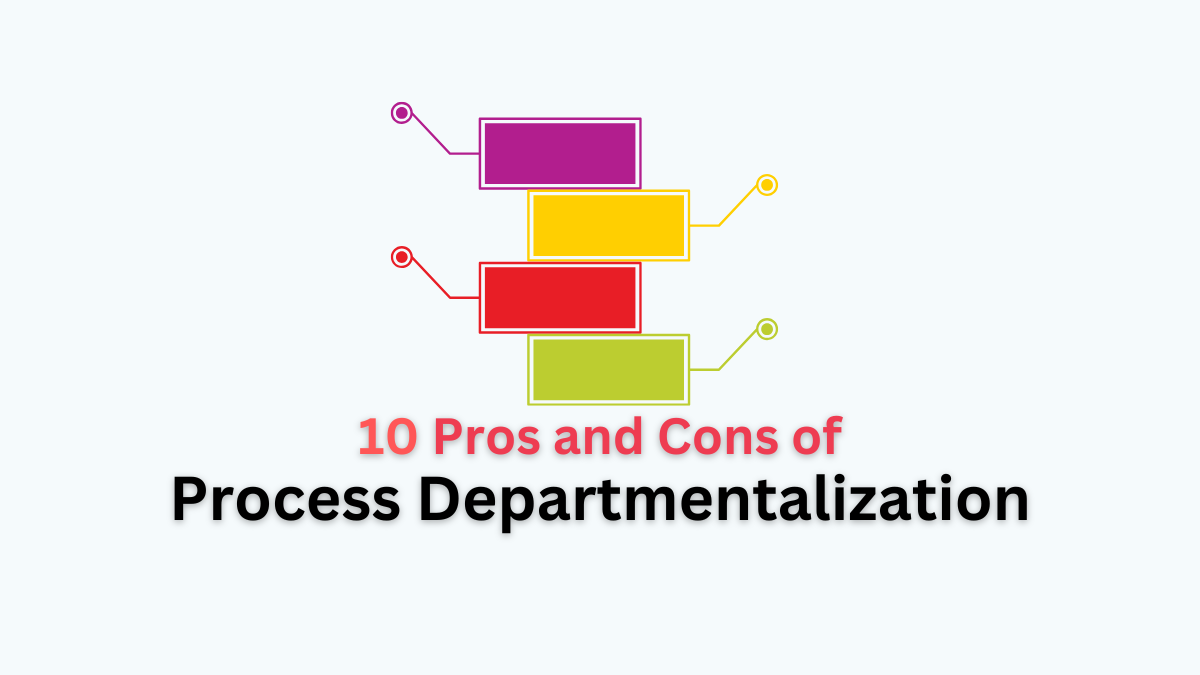Pros and Cons of Process Departmentalization
Process departmentalization is a method of organizing an organization where activities are grouped based on the specific stages or types of processes involved in producing goods or delivering services, each managed by specialized departments. It enhances specialization and efficiency within distinct operational stages.
Here, we will discuss about 10 major pros and cons of process departmentalization in the organization, so let’s get started:
Pros of Process Departmentalization
Let’s explore the five key advantages of process departmentalization in the workplace:
Enhanced Specialization and Expertise
Process departmentalization allows employees within each department to specialize in specific tasks or stages of production. This specialization can lead to higher efficiency and expertise in handling particular processes.
For example, in manufacturing, departments focused on assembly, quality control, and packaging can optimize their operations for maximum efficiency within their specialized domains.
Clear Division of Labor
By dividing work based on processes, there is a clear delineation of responsibilities and tasks within each department. This clarity reduces ambiguity and overlaps in roles, ensuring that each department focuses on its designated functions. This can lead to smoother workflow and reduced conflicts over responsibilities.
Optimized Resource Utilization
Process departmentalization facilitates the efficient allocation and utilization of resources.
Each department can focus on specific resources and equipment required for their processes, optimizing their use without unnecessary duplication. This specialization often leads to cost efficiencies as resources are allocated based on specific operational needs.
Facilitates Coordination within Processes
Departments organized by processes are designed to work cohesively within their specific operational stages.
This structure enhances coordination and communication among employees performing similar tasks, leading to streamlined processes and quicker decision-making within each operational phase.
Read More: 10 Major Pros and Cons of Matrix Organization
Adaptability to Technological Changes
As technology evolves, process departmentalization allows organizations to adapt more easily to technological advancements within specific operational areas.
Departments focused on specialized processes can adopt new technologies and methodologies relevant to their functions without disrupting other parts of the organization.
Disadvantages of Process Departmentalization
While implementing departmentalization by process method, organizations may also face some challenges. Here are the five main drawbacks of process departmentalization:
Potential for Conflict and Competition
Departments organized by processes may prioritize their own goals and efficiencies over the broader organizational objectives. This can create conflicts between departments vying for resources or recognition, potentially leading to internal competition rather than collaboration.
Read More: 10 Major Pros and Cons of Geographical Departmentalization
Complex Coordination Challenges
Coordinating activities across different process-oriented departments can be challenging. Each department may operate with its own set of priorities, timelines, and methods, making it difficult to synchronize activities seamlessly across the organization. This can result in delays, inefficiencies, and missed deadlines.
High Operational Costs
Maintaining multiple specialized departments requires significant financial investment. Each department needs dedicated resources, equipment, and personnel, which can increase operational costs.
Additionally, there may be costs associated with training specialized staff and maintaining distinct facilities for each process.
Read More: 10 Major Pros and Cons of Product Departmentalization
Potential for Duplication of Efforts
Process departmentalization may lead to duplication of efforts across different departments performing similar tasks at different stages of the process. This redundancy can result in inefficiencies and increased costs, as resources and efforts are duplicated rather than consolidated for optimal use.
Challenges in Maintaining Unity of Command
Ensuring a clear chain of command and authority becomes challenging in process departmentalization.
Employees within a single department may report to different managers or supervisors depending on the process stage, leading to confusion or conflicting directives. This can hinder decision-making and coordination across the organization.
Hence, the above listed are the 10 major pros and cons of process departmentalization in business.
Read Next: The 10 Major Pros and Cons of Job Rotation
